
Guest bedrooms are nice to have, but they usually require a dedicated room that is then typically under-used. Here’s a great way to create a multipurpose room that can still accommodate your guests comfortably!
There are a number of ways in which you can improve a room to maximize its use. But one should consider several factors in deciding which option is best.
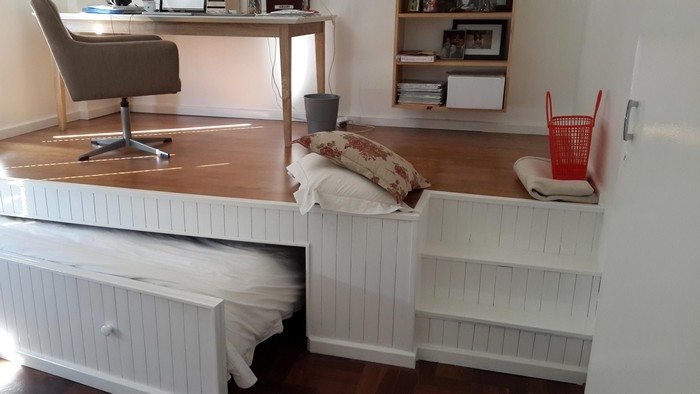
A pull-out bed under a platform floor is one of the many ways to make a room multi-purpose. This is a good idea if you are not always using the bed. For instance, if you want to dual-purpose your guest room a home office, study, or mini-library.
This is also a great alternative to a loft bed for older kids who ‘need their own space’.
Is this the kind of bedroom makeover that suits your needs?
Contents
- 1 Building a Pull-Out Bed
- 2 Design Ideas for Pull-Out Beds in Small Spaces
- 3 Integrating Technology into Your Pull-Out Bed Design
- 4 Safety Considerations and Best Practices
- 5 FAQ on Building a Pull-Out Bed
- 5.1 How do I ensure the pull-out bed fits my space?
- 5.2 Can I build a pull-out bed if I have limited woodworking experience?
- 5.3 How can I customize my pull-out bed?
- 5.4 How do I maintain and care for my pull-out bed?
- 5.5 What should I do if the bed isn’t stable?
- 5.6 Can I add storage to my pull-out bed?
- 6 Conclusion
Building a Pull-Out Bed
Materials
- 2×4 Timber
- 3/4″ Plywood
- 20mm Chipboard
- Laminate Flooring
- L Brackets
- Wheel Casters with lock
- Screws
- Drawer Handles (for the pull-out bed)
- Wood Filler
- Wood Primer
- White Enamel Paint
- Carpenter’s Tape
Tools
- Measuring Tape
- Spirit Level
- Circular Saw
- Cordless Drill
- Hammer
- Square
- Paint Brush
Instructions
Step 1: Design and Planning
- Measure the space where the pull-out bed will be placed, ensuring there’s enough clearance for when the bed is extended.
- Sketch your design, including dimensions for the bed frame and the platform under which it will slide. The pull-out bed will typically fit a twin-size mattress, but dimensions can be adjusted as needed.
Step 2: Building the Bed Frame
- Cut the 2×4 timber to create the frame for the mattress. You’ll need four pieces for the sides and additional pieces for support slats across the frame.
- Assemble the frame using the cordless drill and screws. Place the support slats evenly across the frame and secure them in place.
Step 3: Preparing the Platform Base
- Cut the 3/4″ plywood to the size of your designed platform. This will serve as the base on which the mattress frame will rest.
- Use the 20mm chipboard to create a surrounding edge around the plywood base, creating a lip that prevents the bed frame from slipping off.
Step 4: Adding the Floor and Casters
- Apply laminate flooring to the top of the plywood base for a finished look. Cut the laminate pieces to size and secure them with appropriate adhesive.
- Flip the base over and attach wheel casters with locks at each corner and, if needed, the center for additional support. These casters will allow the bed to roll out smoothly and lock in place when in use.
Step 5: Assembling the Pull-Out Mechanism
- Place the bed frame on top of the platform base to ensure it fits within the chipboard edges and rolls out smoothly.
- Attach drawer handles to the end of the bed frame for easy pulling.
Step 6: Finishing Touches
- Fill any screw holes or imperfections in the timber with wood filler. Let it dry according to the product instructions, then sand smooth.
- Apply wood primer to the entire bed frame and platform base, followed by a coat of white enamel paint for a clean, finished look. Use the paint brush for a smooth application.
Step 7: Testing and Final Adjustments
- Once the paint has dried, test the pull-out mechanism to ensure the bed rolls out smoothly and locks in place securely.
- Adjust the placement of the wheel casters or add more support slats if necessary to ensure stability and comfort.
Design Ideas for Pull-Out Beds in Small Spaces
Pull-out beds emerge as a brilliant solution to maximize the utility and aesthetic appeal of small living spaces. These versatile pieces of furniture not only save space but also enhance the functionality of any room, allowing it to serve multiple purposes without compromising on comfort or style.
Whether you’re living in a compact apartment, a studio, or simply wish to make the most out of a small guest room, integrating a pull-out bed can transform your living area into a multi-functional and stylish space. Here are some innovative design ideas for incorporating pull-out beds into small spaces.
Dual-Purpose Furniture
Convertible Sofas: A classic and ubiquitous choice, convertible sofas that turn into beds are perfect for the living room or den. By day, they offer comfortable seating, and they transform into a cozy bed by night. Modern designs have improved mechanisms for easy conversion and enhanced comfort.
Desk Bed Combo: Ideal for a home office or study room that needs to double as a guest room. A desk bed combo allows the desk to fold away or transform into a part of the bed frame, ensuring you don’t have to sacrifice workspace for sleeping space.
Hidden Beds in Cabinetry
Murphy Beds: The quintessential space saver, Murphy beds pull down from the wall or a cabinet, providing a full-sized bed without taking up floor space when not in use. Custom cabinetry can make the bed invisible when folded up, blending seamlessly with the room’s decor.
Pop-Up Trundle Beds: A trundle bed with a pop-up mechanism can be stored under a platform bed or daybed, making it an excellent option for children’s or guest rooms. It’s easy to set up when needed and hidden away when not, maximizing floor space.
Under-Stair Pull-Out Beds
For homes with staircases, the under-stair area often goes unused. Designing a pull-out bed to fit this space can be an ingenious way to utilize every inch of your home. With custom design, the bed can slide out smoothly and be tucked away when not needed, offering a novel sleeping solution without encroaching on living areas.
Lofted Spaces
In rooms with high ceilings, a lofted space for a pull-out bed can free up the floor for other uses. The bed can be designed to pull out from beneath the loft, offering a cozy sleeping nook that doesn’t interfere with the functionality of the room below, such as a home office, living area, or storage space.
Multi-Level Bed Systems
For kids’ rooms or vacation homes where space is at a premium, a multi-level bed system with pull-out beds can be a game-changer. These systems can include a mix of bunk beds and pull-out beds, ensuring that the room can accommodate multiple sleepers without permanent bed frames taking up valuable space.
Custom Solutions for Unique Spaces
Every small space presents unique challenges and opportunities. Custom-designed pull-out beds can be tailored to fit odd angles, recessed walls, or narrow spaces, ensuring no area is wasted. This approach allows homeowners to fully personalize their space, making the pull-out bed a perfect fit for the room’s size and aesthetic.
Pull-out beds offer a smart solution for small spaces, blending functionality with design creativity. With the right type of pull-out bed and integrating it thoughtfully into your home, you can enjoy a flexible living space that meets your needs without sacrificing style or comfort.
Look at more beautiful examples of this idea below for your inspiration. You can also get the link to the complete details of the featured project below the gallery! :)
Click on any image to start the lightbox display. Use your Esc key to close the lightbox.![]()
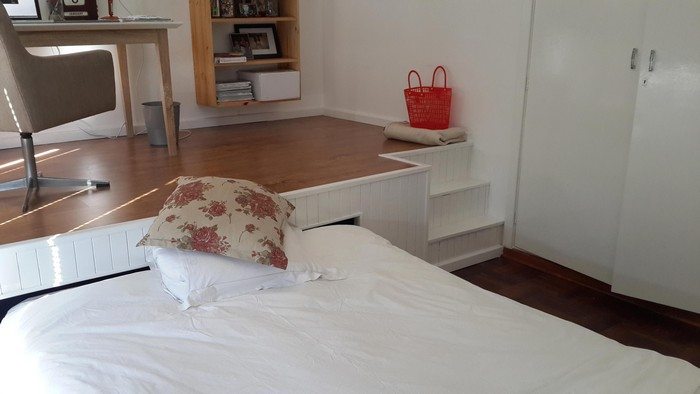

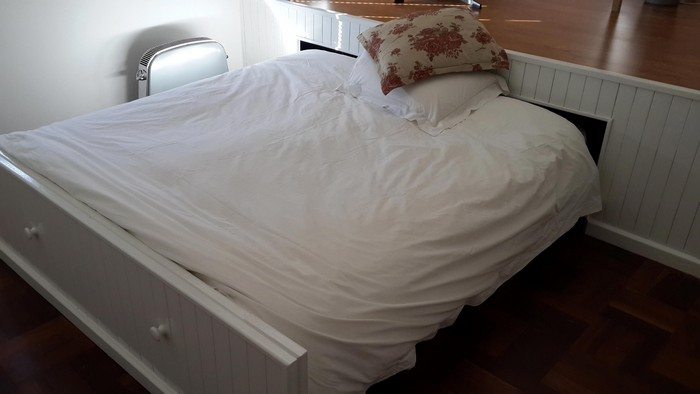
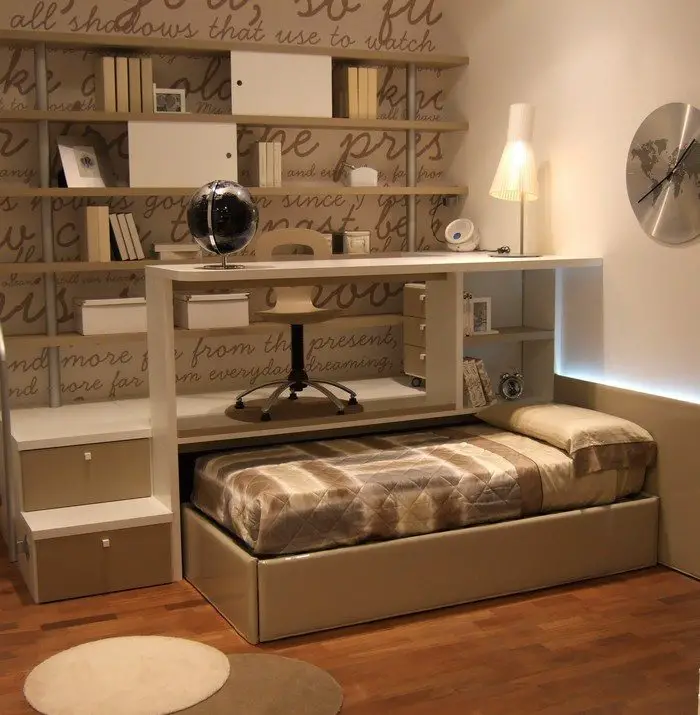
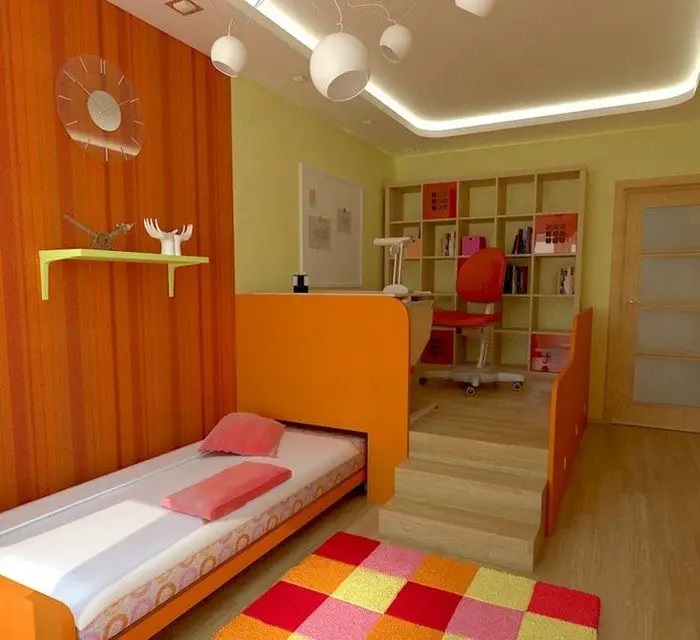
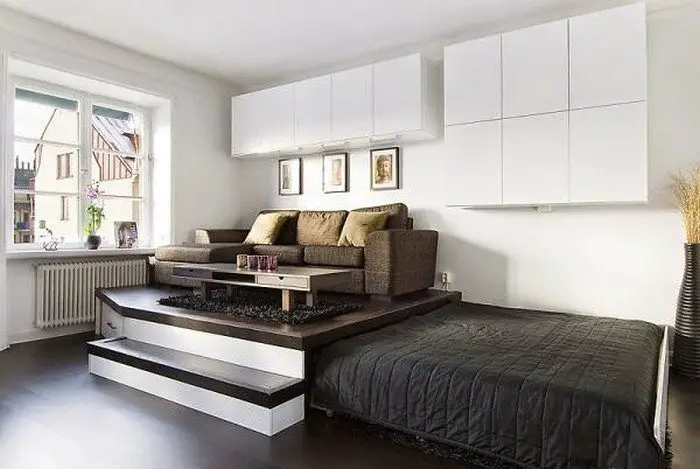
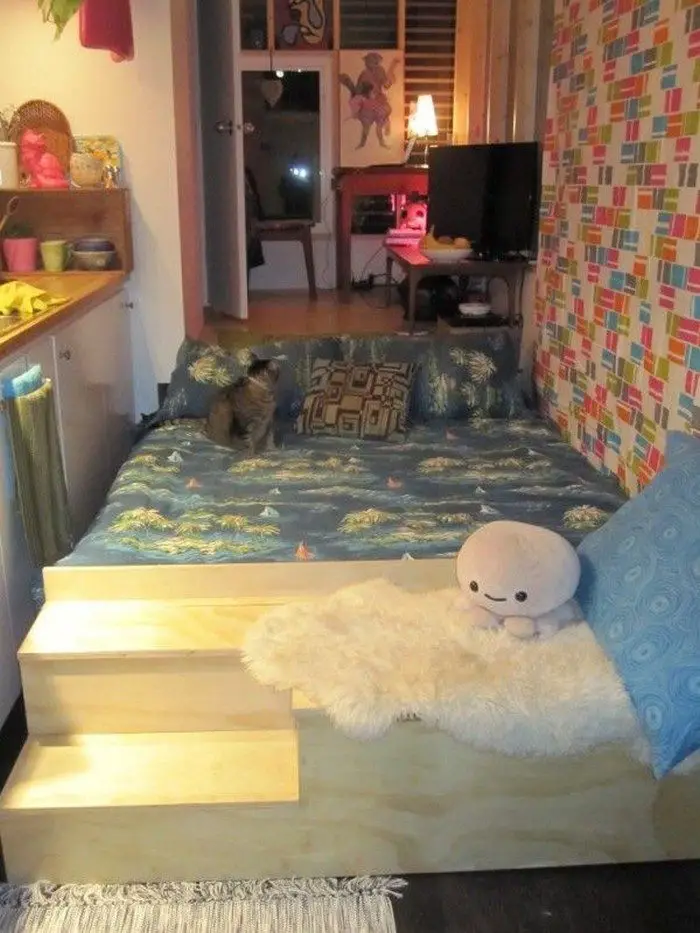
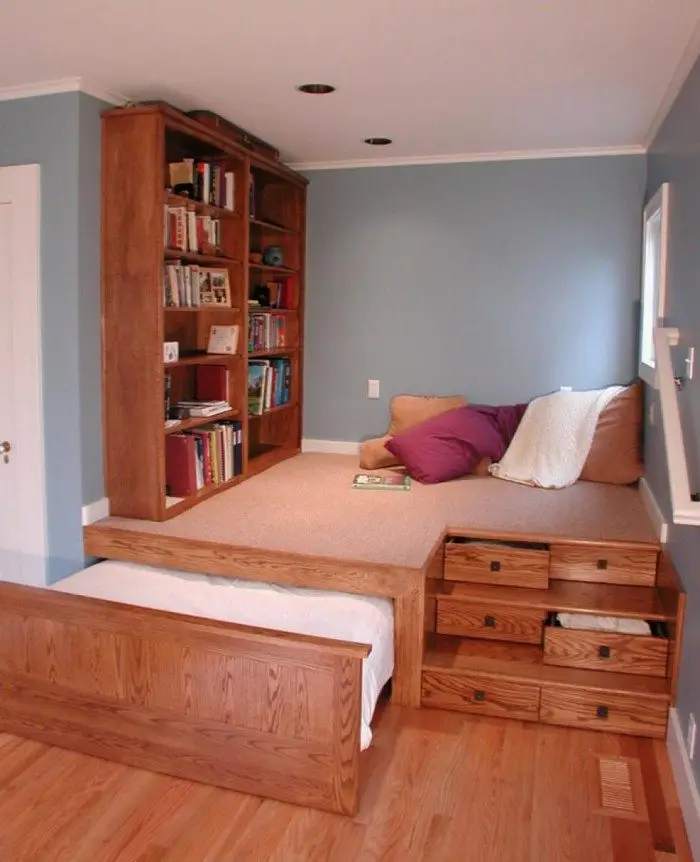
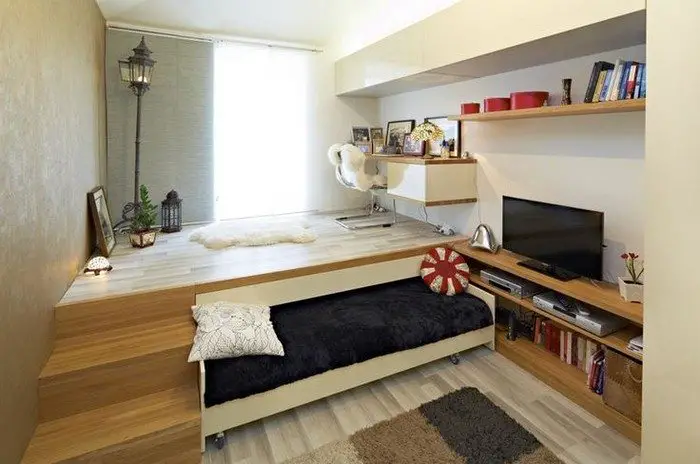
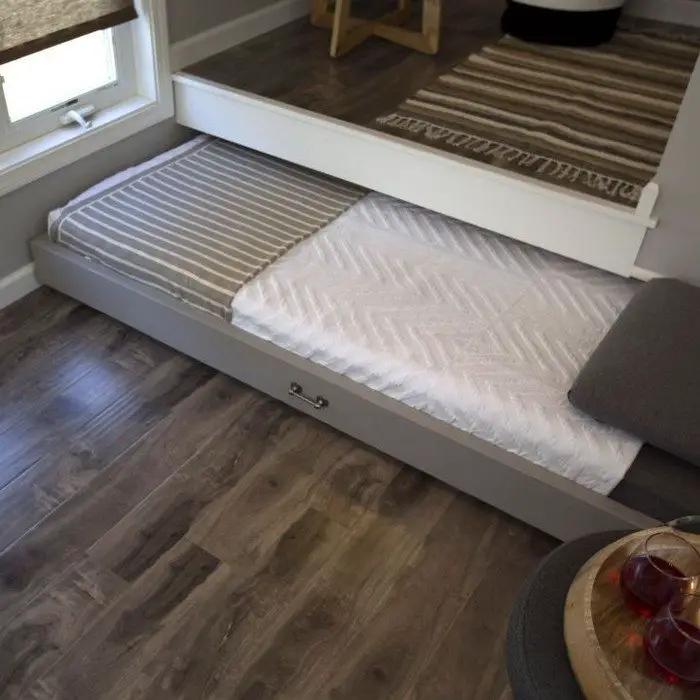
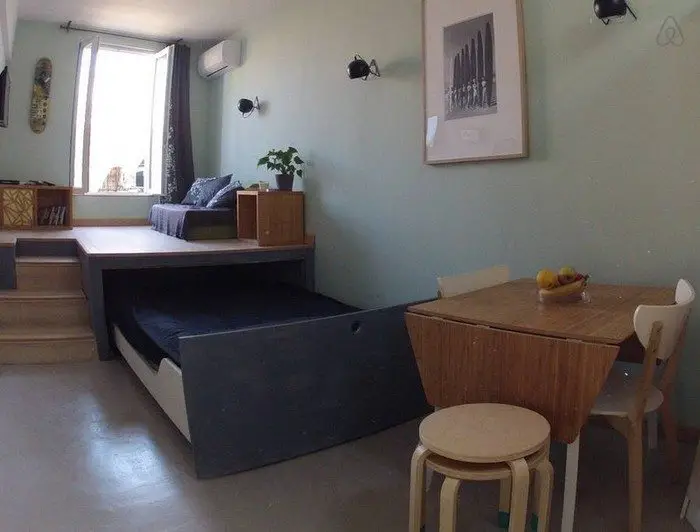
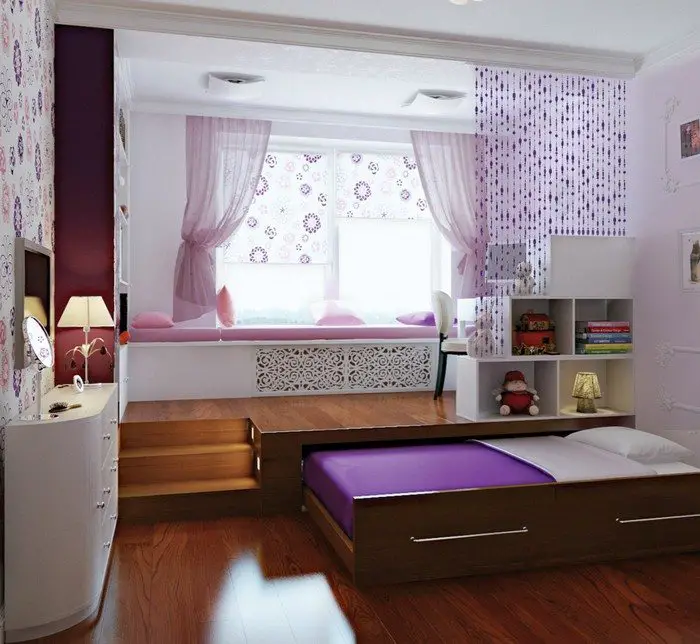
You can get step-by-step instructions over here…
Integrating Technology into Your Pull-Out Bed Design
In the modern home, technology is pivotal in enhancing convenience, comfort, and entertainment. Integrating technology into your pull-out bed design not only maximizes the functionality of your living space but also elevates the overall experience of using a pull-out bed.
Here’s how to seamlessly blend technology with your pull-out bed to create a space that’s both innovative and comfortable.
Smart Lighting Solutions
Adjustable LED Lighting: Embedding LED strips around the frame of your pull-out bed can provide ambient lighting that adjusts to your mood or needs. With smart controls, you can change the color, brightness, and even set schedules or triggers (like turning on when the bed is pulled out), enhancing the space’s utility and atmosphere.
Touch-Activated Lamps: For reading or night-time use, consider integrating touch-activated lamps into your pull-out bed’s headboard or side panels. These can be conveniently turned on or off with a simple touch, eliminating the need for fumbling around for a switch in the dark.
Charging Stations and Connectivity
Built-In USB Ports: Incorporating USB charging ports within the pull-out bed frame or headboard allows smartphones, tablets, and other devices to easily charge. This feature is especially handy if the pull-out bed is used in a multifunctional space where accessibility to charging options might be limited.
Bluetooth Speakers: Embedding Bluetooth speakers into the frame of your pull-out bed can turn the bed into an entertainment station, perfect for watching movies, listening to music, or even setting alarms. This integration can be particularly appealing in guest rooms or children’s bedrooms, offering an extra element of fun and functionality.
Smart Mattress Technology
Temperature Control: Some modern mattresses come with temperature control technology, allowing users to warm or cool their bed for a comfortable night’s sleep. Integrating such a mattress with your pull-out bed can provide personalized comfort that adapts to seasonal changes or personal preferences.
Sleep Monitoring: Consider a smart mattress that tracks sleep patterns and provides feedback on sleep quality. This technology can help guests or family members optimize their sleep environment for a better night’s rest when used with a pull-out bed.
Automated Mechanisms
Remote-Controlled Bed Deployment: To enhance convenience, especially for pull-out beds used in tight spaces, implementing a remote-controlled mechanism for deploying and retracting the bed can make the process effortless. This feature is particularly useful for those with mobility issues or when the bed is heavy.
Voice-Activated Controls: Integrating your pull-out bed with smart home systems like Alexa or Google Home can allow for voice-activated commands to control lighting, deploy the bed, or even adjust smart mattress settings, offering the ultimate in convenience and modern living.
Incorporating technology into your pull-out bed design makes the bed more functional and convenient and turns it into a highlight of your home’s technological integration. With thoughtful selection and implementation of smart features, your pull-out bed can become a cornerstone of a modern, efficient, and comfortable living space.
Safety Considerations and Best Practices
Building a pull-out bed can be a rewarding DIY project that adds functionality and style to your living space. However, ensuring the safety and durability of your creation is paramount. This guide outlines essential safety considerations and best practices to follow when constructing a pull-out bed, ensuring it is safe, comfortable, and long-lasting.
Design and Materials
Choose the Right Materials: Select high-quality, durable bed frame and platform materials. Ensure the timber, plywood, and chipboard are free from defects and have the strength to support the weight of the mattress and occupants.
Safety in Design: Design the bed with rounded corners and smooth edges to minimize the risk of injury. Consider the bed’s weight capacity, ensuring it can safely hold the intended load without risk of collapse.
Construction Safety
Wear Protective Gear: Always wear safety glasses, gloves, and appropriate clothing to protect against splinters, dust, and debris when cutting wood or drilling.
Use Tools Correctly: Familiarize yourself with each tool’s operation before beginning your project. Follow manufacturer guidelines for safe use, particularly when operating power tools like circular saws and drills.
Secure Work Area: Ensure your work area is well-lit, clean, and free from hazards. Keep tools and materials organized to prevent trips and falls.
Installation of Mechanisms
Secure Mounting: When attaching wheel casters and drawer handles, ensure they are securely fastened to the bed frame and platform. Use the appropriate size and length of screws to prevent them from loosening over time.
Locking Mechanisms: Choose wheel casters with robust locking mechanisms to prevent the bed from rolling unexpectedly. Test the locks regularly to ensure they remain effective.
Finishing and Maintenance
Non-Toxic Finishes: Use non-toxic wood fillers, primers, and paints to minimize the risk of exposure to harmful chemicals. Ensure the room is well-ventilated during painting and allow enough time for the paint to fully cure before use.
Regular Inspections: Periodically inspect the bed for any signs of wear and tear, especially focusing on the bed’s frame, platform base, and wheel casters. Tighten any loose screws and replace parts that show signs of damage or excessive wear.
Child Safety
Childproofing: If the pull-out bed is accessible to children, incorporate additional safety measures. Install guards or railings on the bed to prevent falls and ensure young children cannot easily operate the pull mechanism to avoid accidental injuries.
Supervision: Always supervise young children when they are using or near the pull-out bed. Teach them safe practices, such as not jumping on the bed and ensuring the bed is fully extended and locked before use.
Best Practices for Longevity
Weight Distribution: Evenly distribute weight across the bed to avoid undue stress on any part of the frame or platform. This helps in maintaining the structural integrity of the bed over time.
Maintenance Routine: Develop a routine for checking and maintaining the bed, including tightening screws, lubricating moving parts, and cleaning the bed frame and mattress. This routine will help extend the life of your pull-out bed and ensure it remains safe and comfortable for use.
Following these safety considerations and best practices will help you create a pull-out bed that is functional, aesthetically pleasing but also safe, and durable. Safety should always be the top priority in any DIY project, ensuring your creations can be enjoyed without risk.
FAQ on Building a Pull-Out Bed
How do I ensure the pull-out bed fits my space?
Can I build a pull-out bed if I have limited woodworking experience?
How can I customize my pull-out bed?
How do I maintain and care for my pull-out bed?
What should I do if the bed isn’t stable?
Can I add storage to my pull-out bed?
Conclusion
Building a pull-out bed is a rewarding project that not only enhances the functionality of your living space but also offers a creative solution to the common problem of limited space. By following the step-by-step instructions, utilizing the specified materials and tools, and considering the best practices and safety considerations, you can construct a durable, stylish, and practical pull-out bed that meets your needs.





